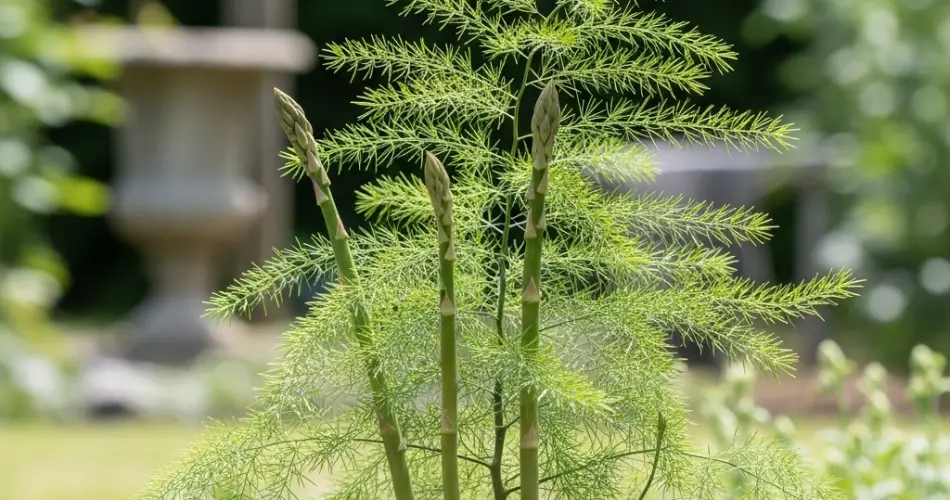Asparagus is one of the most rewarding perennial vegetables a gardener can grow. Its tender green spears are a springtime delicacy, prized for their unique flavor and rich nutritional content. While it does require some patience to establish, asparagus plants can produce abundant harvests for up to 20 years with proper care.
Whether you’re an experienced gardener or just starting out, adding asparagus to your garden is a long-term investment in flavor, sustainability, and health.
Why Grow Asparagus?
Asparagus is a nutritional powerhouse. It’s low in calories but rich in essential nutrients like vitamins A, C, E, and K, along with folate, fiber, and antioxidants. It’s known for supporting digestion, reducing inflammation, and offering natural diuretic properties.
Growing your own asparagus ensures a fresh supply of this seasonal treat every spring. Unlike most vegetables that need to be replanted each year, asparagus is a perennial. Once established, it reliably produces spears each season with minimal effort.
Choosing the Right Variety
There are several varieties of asparagus, each offering slightly different flavors, yields, and growing habits:
-
-
Mary Washington – A popular heirloom variety known for its reliability and disease resistance.
-
Jersey Giant / Jersey Knight – All-male hybrids that offer high yields and improved disease resistance.
-
-
Purple Passion – A unique purple variety with a slightly sweeter taste and tender texture.
-
UC 157 – A high-yield hybrid often used in commercial growing, especially in warmer climates.
Choose a variety based on your climate, soil conditions, and taste preferences. Many gardeners prefer all-male hybrids because they tend to produce thicker, more uniform spears and greater yields
Planting Asparagus: Crowns vs. Seeds
Asparagus can be grown from seeds or crowns (1-year-old roots). While seeds are less expensive, starting with crowns saves time and leads to quicker harvests
Plant crowns in early spring, as soon as the soil can be worked. Choose a sunny location with well-draining soil enriched with compost or aged manure. Asparagus thrives in slightly acidic to neutral soil (pH 6.5–7.5).
To plant, dig a trench about 6 to 8 inches deep and 12 to 18 inches wide. Space crowns 12 to 18 inches apart and cover with 2 inches of soil. As the plants grow, gradually fill in the trench until it is level with the soil surface.
Patience Pays Off: The First Few Years
Asparagus requires a waiting period before you can enjoy a full harvest. In the first year after planting crowns, avoid harvesting altogether. Allow the plants to grow and build strong root systems.
In the second year, harvest lightly for just 2 to 3 weeks. By the third year, you can begin harvesting more freely—usually for about 6 to 8 weeks each spring.
This initial patience pays off with years of future harvests. Once established, asparagus plants produce reliably with minimal maintenance.
Watering and Maintenance
Asparagus prefers consistently moist soil, especially during the growing season. Deep watering is more effective than frequent shallow watering, as it encourages deep root growth.
Apply mulch around the base of the plants to retain moisture, suppress weeds, and protect crowns from temperature fluctuations.
After the final harvest in spring, allow the ferns to grow out fully. These tall, feathery fronds feed the roots and help the plant store energy for next year’s growth. Cut them back only after they turn brown and die back in fall or early winter.
Pests and Diseases
Asparagus is relatively pest-resistant, but common issues include asparagus beetles, aphids, and rust.
-
Asparagus beetles chew on spears and lay eggs on plants. Handpick beetles and use neem oil as needed.
-
Rust is a fungal disease that appears as reddish spots on stems and leaves. Plant rust-resistant varieties and avoid overhead watering.
Keep the bed weed-free and rotate crops nearby to reduce disease pressure.
Harvesting Asparagus
Once your asparagus patch is established, you’ll be able to harvest in early to mid-spring. Use a sharp knife or snap the spears by hand when they are 6 to 8 inches tall and about as thick as your finger.
Harvest spears every few days to prevent them from becoming tough or woody. Stop harvesting when the spears become thin, and allow the plants to regrow their ferns for the rest of the season.
Enjoying Asparagus in the Kitchen
Freshly harvested asparagus is incredibly versatile. It can be steamed, grilled, roasted, sautéed, or eaten raw in salads. Its mild, grassy flavor pairs beautifully with lemon, garlic, butter, cheese, and herbs like thyme or tarragon.
For a quick and healthy side, drizzle spears with olive oil, season with salt and pepper, and roast in the oven until tender. Or toss them on the grill for a smoky, charred finish.
With its long-term yield, elegant form, and rich flavor, asparagus is a garden favorite worth the initial wait. From planting to plating, this hardy perennial brings lasting rewards and a touch of gourmet flair to any homegrown meal.
